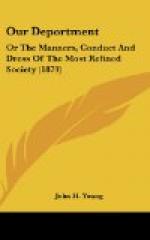VISITING COSTUMES.
Visiting costumes, or those worn at a funeral or informal calls, are of richer material than walking suits. The bonnet is either simple or rich, according to the taste of the wearer. A jacket of velvet, or shawl, or fur-trimmed mantle are the concomitants of the carriage dress for winter. In summer all should be bright, cool, agreeable to wear and pleasant to look at.
DRESS FOR MORNING CALLS.
Morning calls may be made either in walking or carriage dress, provided the latter is justified by the presence of the carriage. The dress should be of silk; collar and cuffs of the finest lace; light gloves; a full dress bonnet and jewelry of gold, either dead, burnished or enameled, or of cameo or coral. Diamonds are not usually worn in daylight. A dress of black or neutral tint, in which light colors are introduced only in small quantities, is the most appropriate for a morning call.
MORNING DRESS FOR STREET.
The morning dress for the street should be quiet in color, plainly made and of serviceable material. It should be short enough to clear the ground without collecting mud and garbage. Lisle-thread gloves in midsummer, thick gloves in midwinter, are more comfortable for street wear than kid ones. Linen collars and cuffs are most suitable for morning street dress. The bonnet and hat should be quiet and inexpressive, matching the dress as nearly as possible. In stormy weather a large waterproof with hood is more convenient and less troublesome than an umbrella. The morning dress for visiting or breakfasting in public may be, in winter, of woolen goods, simply made and quietly trimmed, and in summer, of cambric, pique, marseilles or other wash goods, either white or figured. For morning wear at home the dress may be still simpler. The hair should be plainly arranged without ornament.
THE PROMENADE DRESS.
The dress for the promenade should be in perfect harmony with itself. All the colors worn should harmonize if they are not strictly identical. The bonnet should not be of one color, and parasol of another, the dress of a third and the gloves of a fourth. Nor should one article be new and another shabby. The collars and cuffs should be of lace; the kid gloves should be selected to harmonize with the color of the dress, a perfect fit. The jewelry worn should be bracelets, cuff-buttons, plain gold ear-rings, a watch chain and brooch.
OPERA DRESS.
Opera dress for matinees may be as elegant as for morning calls. A bonnet is always worn even by those who occupy boxes, but it may be as dressy as one chooses to make it. In the evening, ladies are at liberty to wear evening dresses, with ornaments in their hair, instead of a bonnet, and as the effect of light colors is much better than dark in a well-lighted opera house, they should predominate.




